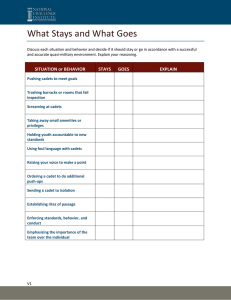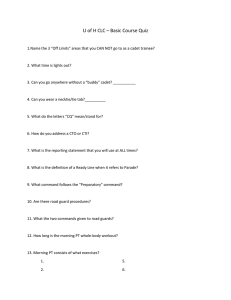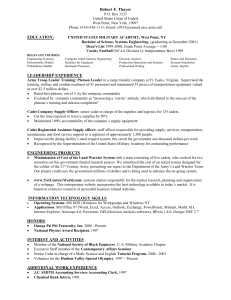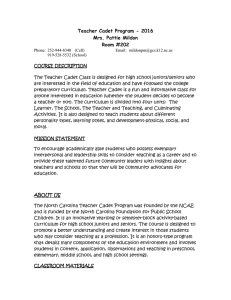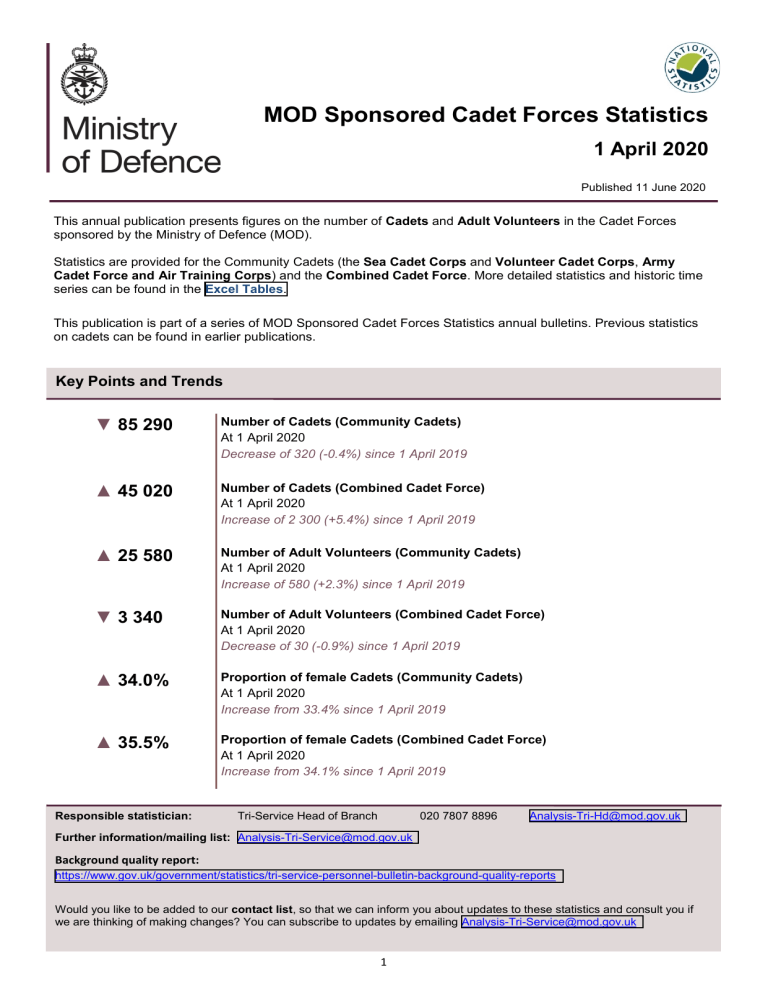
MOD Sponsored Cadet Forces Statistics 1 April 2020 Published 11 June 2020 This annual publication presents figures on the number of Cadets and Adult Volunteers in the Cadet Forces sponsored by the Ministry of Defence (MOD). Statistics are provided for the Community Cadets (the Sea Cadet Corps and Volunteer Cadet Corps, Army Cadet Force and Air Training Corps) and the Combined Cadet Force. More detailed statistics and historic time series can be found in the Excel Tables. This publication is part of a series of MOD Sponsored Cadet Forces Statistics annual bulletins. Previous statistics on cadets can be found in earlier publications. Key Points and Trends ▼ 85 290 Number of Cadets (Community Cadets) At 1 April 2020 Decrease of 320 (-0.4%) since 1 April 2019 ▲ 45 020 Number of Cadets (Combined Cadet Force) At 1 April 2020 Increase of 2 300 (+5.4%) since 1 April 2019 ▲ 25 580 Number of Adult Volunteers (Community Cadets) At 1 April 2020 Increase of 580 (+2.3%) since 1 April 2019 ▼ 3 340 Number of Adult Volunteers (Combined Cadet Force) At 1 April 2020 Decrease of 30 (-0.9%) since 1 April 2019 ▲ 34.0% Proportion of female Cadets (Community Cadets) At 1 April 2020 Increase from 33.4% since 1 April 2019 ▲ 35.5% Proportion of female Cadets (Combined Cadet Force) At 1 April 2020 Increase from 34.1% since 1 April 2019 Responsible statistician: Tri-Service Head of Branch 020 7807 8896 Analysis-Tri-Hd@mod.gov.uk Further information/mailing list: Analysis-Tri-Service@mod.gov.uk Background quality report: https://www.gov.uk/government/statistics/tri-service-personnel-bulletin-background-quality-reports Would you like to be added to our contact list, so that we can inform you about updates to these statistics and consult you if we are thinking of making changes? You can subscribe to updates by emailing Analysis-Tri-Service@mod.gov.uk 1 Contents Introduction page 2 Background and Context page 3 Community Cadet Forces page 4 (NS) Combined Cadet Force page 6 (NS) Further Information page 8 Glossary page 9 Supplementary tables containing further statistics can be found at: https://www.gov.uk/government/statistics/mod-sponsored-cadet-forces-statistics-2020 The Background Quality Report is available at: https://www.gov.uk/government/statistics/tri-service-personnel-bulletin-background-quality-reports Introduction This annual publication presents figures on the number of Cadets and Adult Volunteers in the Cadet Forces sponsored by the Ministry of Defence. It includes age and gender breakdowns of the Cadets, and gender breakdowns of the Adult Volunteers. The Ministry of Defence sponsors and supports five Cadet Forces (voluntary youth organisations). They comprise the Community Cadets (Sea Cadet Corps, Volunteer Cadet Corps, Army Cadet Force and Air Training Corps) and the school-based Combined Cadet Force, whose contingents contain one or more sections from the Royal Navy, Royal Marines, Army or Royal Air Force. The Cadet Forces provide young people with interesting and challenging activities as part of a stimulating syllabus that develops valuable life skills. In addition, the Cadet Forces encourage young people to take an interest in Defence and the Armed Forces and, for those considering careers in the Services, shows them the various opportunities that exist. The Cadet Forces are not part of the Armed Forces, and members of the Cadet Forces do not have any liability for military service or compulsory training in the Armed Forces (Regular or Reserve). The Cadet Forces are not conduits for entry into the Armed Forces – this position is clearly stated in the UK’s commitment to the UN Convention on the Rights of the Child. The next edition of this publication is provisionally scheduled to be released on GOV.UK at 9.30am on 27 May 2021. A calendar of upcoming MOD statistical releases can be found on GOV.UK. A National Statistics publication The United Kingdom Statistics Authority has designated these statistics as National Statistics, in accordance with the Statistics and Registration Service Act 2007 and signifying compliance with the Code of Practice for Official Statistics. This publication has since undergone a change in presentation following a public consultation, though the underlying methodology of producing the data remains unchanged. The MOD continues to seek feedback from users to ensure this publication is meeting user needs. Designation can be broadly interpreted to mean that the statistics: • • • • meet identified user needs; are well explained and readily accessible; are produced according to sound methods; and are managed impartially and objectively in the public interest. Once statistics have been designated as National Statistics it is a statutory requirement that the Code of Practice shall continue to be observed. 2 Background and Context Key Policies MOD Single Departmental Plan The MOD’s Single Departmental Plan1 states under the third objective, ‘Promote Our Prosperity’, that the Department will contribute to the promotion of UK prosperity and civil society by providing MOD Sponsored Cadet Forces. Cadet Force Strategy The Cadet Force Strategy was initiated in March 2015 and updated in June 2018, to look out to 2025. It is a tri-service strategy which encompasses the strategic intent for each of the five MOD-sponsored Cadet Forces and ensures a coherent direction of travel and unity of effort. The Cadet Force Strategy Vision is for ‘a challenging and stimulating contemporary cadet experience that develops and inspires young people within a safe environment’. The strategy recognises that the critical success factor for the Cadet Forces is the continuing commitment of sufficient high-quality adult volunteers to deliver the cadet experience. Cadet Expansion Programme The Cadet Expansion Programme (CEP) was launched in June 2012 by the then Prime Minister and Deputy Prime Minister, with an initial aim of establishing 100 new cadet units in English state-funded secondary schools by September 2015. Following successful delivery of this target the Government committed £50m from LIBOR fines to cover set up costs, uniforms, equipment and training to grow the total number of cadet units in schools across the UK to 500 by March 2020. This target was reached in November 2019, 6 months early.2 The number of schools across the UK with cadet units has almost doubled since the start of the program, now with more units in state schools than in independent schools. At the Conservative Party Conference in September 2018 the then Secretary of State (SofS) for Defence announced a further Government ambition to increase the number of cadets in school units from c.43,000 to 60,000 (by 2024). Safeguarding Safeguarding young people is our priority and we have procedures in place to protect cadets. This includes mandatory security and background checks for all adults who work with children, rigorous disclosure procedures and regular safeguarding training. The MODs approach to Safeguarding is set out in its Safeguarding Framework 2019. 1 https://www.gov.uk/government/publications/ministry-of-defence-single-departmental-plan/ministry-of-defence-single-departmental-plan-2019 2 https://www.gov.uk/government/news/cadet-expansion-programme-reaches-500-unit-target 3 Community Cadets As at 1 April 2020, there were 85,290 cadets in the Community Cadets, made up of 14,670 Sea Cadets, 460 in the Volunteer Cadet Corps, 37,410 Army Cadets and 32,760 Air Cadets. There has been a decrease in the total number of cadets since 1 April 2016 (86,720 cadets), influenced mainly by the decrease in Army Cadet numbers (see Figure 1). The number of Air Cadets has reduced since 1 April 2016 and decreased by 90 (0.3%) since 1 April 2019. The number of Sea Cadets has increased since 1 April 2016 and by 130 (0.9%) since 1 April 2019. Volunteer Cadet Corps numbers are not shown in Figure 1 due to their relatively small size. Figure 1: Number of Cadets in the Community Cadets Since April 16: 50 000 40 000 Decrease of 2 360 (5.9%) 30 000 Decrease of 100 (0.3%) 20 000 Increase of 570 (4.0%) 10 000 0 Apr 16 Apr 17 Sea Cadet Corps Apr 18 Apr 19 Army Cadet Force Community Cadet Forces include the Sea Cadet Corps (SCC), Volunteer Cadet Corps (VCC), Army Cadet Force (ACF) and Air Training Corps (ATC). (See glossary). Adult Volunteers include uniformed and non-uniformed volunteers. (See glossary). Apr 20 Air Training Corps Figure 2: Number of Cadets in the Community Cadets by Gender Gender Female representation in the Community Cadet Forces has increased slightly, rising to 34.0% at 1 April 2020 compared with 31.1% at 1 April 2016. However, while the number of female cadets has increased (see Figure 2), the rise in the proportion of female cadets can be partly attributed to the decrease in the number of male cadets over the same period. 70 000 Since April 16: 60 000 Decrease of 3 480 (5.8%) 50 000 40 000 30 000 Increase of 2 050 (7.6%) 20 000 10 000 0 Apr 16 Apr 17 Males Apr 18 Apr 19 Apr 20 Females Figure 3: Proportion of Female Cadets in the Community Cadets as at 1 April 20 % of Cadets 40 The Sea Cadet Corps had the highest proportion of female cadets at 1 April 2020 (39.0%) compared with the Army Cadet Force (34.8%) the Air Training Corps (31.0%) and the Volunteer Cadet Corps (23.8%) shown in Figure 3. Following slight increases to the number of female cadets in the last few years, the SCC, ACF and ATC reached their highest number of female cadets at 1 April 2020. Average 34.0% 30 20 39.0% 34.8% 31.0% 23.8% 10 0 Sea Cadet Corps Army Cadet Force Air Training Corps Volunteer Cadet Corps 4 Community Cadets Age Due to varying age restrictions1 in each of the Cadet Forces, different age distributions can be observed (Figure 4). There is a higher representation of younger cadets in the Sea Cadet Corps, whose largest age group is 13 year olds (16.1% of cadets) and the Volunteer Cadet Corps at 12 year olds (16.6%) compared with the Army Cadet Force and Air Training Corps, whose largest age groups are 14 year olds (22.8% and 23.5% of cadets respectively). 1 Figure 4: Age Distribution of Cadets in the Community Cadets as at 1 April 20 % of Cadets 25 20 15 10 5 0 9 See glossary for age restrictions. 10 11 12 13 14 15 16 17 Sea Cadet Corps Army Cadet Force Air Training Corps Volunteer Cadet Corps 18 19 Age in Years Adult Volunteers As at 1 April 2020, there were 25,580 Cadet Force Adult Volunteers (CFAVs) in the Community Cadets, made up of 4,660 in the Sea Cadet Corps, 150 in the Volunteer Cadet Corps, 9,100 in the Army Cadet Force and 11,680 in the Air Training Corps. Figure 5 shows the changes in CFAV numbers across the Community Cadets since 1 April 2016. Volunteer Cadet Corps numbers are not shown in Figure 5 due to small numbers. Adult Volunteers Gender Figure 5: Number of Adult Volunteers in the Community Cadets Air Training Corps had the highest proportion of female Adult Volunteers at 1 April 2020 (33.7%) - followed by the Sea Cadet Corps (33.6%) and the Army Cadet Force (29.9%) 14 000 While there is a greater proportion of males in both the Uniformed and Non -Uniformed Volunteers, the gender difference is greater in the Uniformed population (68.9% male) compared with Non-Uniformed Volunteers (65.2% male). Since April 16: 12 000 Increase of 1 260 (12.2%) 10 000 Increase of 190 (2.1%) 8 000 6 000 Decrease of 560 (10.7%) 4 000 2 000 0 Apr 16 Apr 17 Sea Cadet Corps Apr 18 Apr 19 Army Cadet Force Apr 20 Air Training Corps Adult to Cadet Ratio The overall ratio of cadets to each Adult Volunteer at 1 April 2020 was 3.3 with variations between the Cadet Forces. 5 Combined Cadet Force As at 1 April 2020, there were 45,020 cadets in the Combined Cadet Force (CCF), made up of 6,140 cadets in the RN & RM sections, 29,920 in the Army sections and 8,960 in the RAF sections. CCF (Army) improved their approach to accounting for cadet numbers at 1 April 2019, which makes comparisons with previous years less reliable. We have not revised the 1 April 2018 count for CCF (Army) cadets in this release but it is possible that it was an over-estimate of the true number. Since 1 April 2016 the total number of cadets across all services has increased slightly. Figure 6: Number of Cadets in the Combined Cadet Force 35 000 Since April 16: 30 000 Increase of 1 360 (4.8%) 25 000 20 000 15 000 Increase of 1 070 (13.6%) 10 000 5 000 0 Apr 16 Combined Cadet Force (CCF) is a school-based youth organisation, comprising sections from one or more of the RN & RM, Army and RAF. (See glossary). Increase of 760 (14.0%) Apr 17 CCF (RN&RM) Apr 18 Apr 19 Apr 20 CCF (Army) CCF (RAF) Gender Female representation in the CCF has increased slightly, rising to 35.5% at 1 April 2020 compared with 31.1% at 1 April 2016. While the overall number of female cadets has increased, the rise in the proportion of female cadets can be partly attributed to the number of male cadets only increasing slightly over the same period (see Figure 7). The proportion of female cadets is the highest it has been in the period since 1 April 2007. Figure 7: Number of Cadets in the Combined Cadet Force by Gender 35 000 Since April 16: 30 000 Increase of 200 (0.7%) 25 000 20 000 15 000 Increase of 2 980 (22.9%) 10 000 5 000 0 Apr 16 Apr 17 Apr 18 Males Apr 19 Apr 20 Females Figure 8: Proportion of Female Cadets in the Combined Cadet Force as at 1 April 20 % of Cadets 0 1 40 Average 35.5% 40 30 20 35.6% 36.5% 32.1% 10 0 0 CCF (RN&RM) CCF (Army) CCF (RAF) Average CCF 6 At 1 April 2020, the Army had the highest proportion of female cadets (36.5%) compared with the RN & RM (35.6%) and the RAF (32.1%). Compared to 1 April 2019, the proportion of female cadets in CCF across all services has increased, with Army section, RN & RM section and RAF section reaching their highest number of female cadets at 1 April 2020. Combined Cadet Force Adult Volunteers As at 1 April 2020, there were 3,340 Cadet Force Adult Volunteers (CFAVs) in the Combined Cadet Force (CCF), made up of 600 in the RN & RM sections, 2,170 in the Army sections and 570 in the RAF sections. Figure 9 shows the changes in CFAVs across the CCF since 1 April 2016. CCF (Army) improved their approach to accounting for CFAVs in 1 April 2019, which makes comparisons with previous years less reliable. We have not revised the 1 April 2018 count for CCF (Army) CFAVs in this release but it is possible that it was an over-estimate of the true number. Since 1 April 2016, the total number of CFAV in the Army section has increased, while the RN & RM section and RAF section total number of CFAV has decreased slightly. Figure 9: Number of Adult Volunteers in the Combined Cadet Force 2 500 Since April 16: 2 000 Increase of 170 (8.4%) 1 500 1 000 Decrease of 20 (3.2%) 500 Decrease of 50 (8.1%) Combined Cadet Force (CCF) is a school-based youth organisation, comprising sections from one or more of the Royal Navy, Royal Marines, Army and the Royal Air Force. (See glossary). 0 Apr 16 Apr 17 Apr 18 CCF (RN&RM) Apr 19 CCF (Army) Apr 20 CCF (RAF) Adult Volunteers Gender The RAF section had the highest proportion of female CFAVs at 1 April 2020 (37.1%), compared with the Army sections (36.5%) the RN & RM sections (33.8%). While there is a greater proportion of males in both the Uniformed and Non-Uniformed Volunteers, the gender difference is greater in the Uniformed Volunteers (64.0% male) compared with Non-Uniformed population (63.3% male) . Adult to Cadet Ratio The overall ratio of Combined Cadet Force Cadets to each Adult Volunteer at 1 April 2020 was 13.5 with variations between the sections. Please note that this ratio may differ across individual cadet units. 7 Further Information Rounding Figures in this publication have been rounded to the nearest 10, though numbers ending in a “5” have been rounded to the nearest multiple of 20 to prevent the systematic bias caused by always rounding numbers upwards. For example; a value of “25” would be rounded down to “20” and a value of “15” would be rounded up to “20”. Totals and sub-totals are rounded separately and so may not equal the sums of their rounded parts. Percentages are calculated from unrounded data and presented to one decimal place. Revisions There have been revisions in Table 4 to 1 April 2016 data due to a data processing issue. This has impacted 150 personnel in the Combined Cadet Force and subsequent totals have been revised. There have been revisions in Table 5 to 1 April 2016 data due to a data processing issue. This has impacted 20 personnel in the Combined Cadet Force and subsequent totals have been revised. Data sources: Data are derived from two management information systems which the individual Cadet Force Headquarters use to administer their Cadets and Cadet Force Adult Volunteers. These systems undergo continuous improvements in data quality and coverage. These improvements are not considered material enough at this time to warrant a break in series. Data quality: In 2020, the COVID-19 pandemic impacted the ability of cadets and Cadet Force Adult Volunteers to attend parade evenings which directly impacted the recording and processing of applications to join each respective Cadet Force. Some administrative processes are likely to have been delayed. Symbols || * .. – ~ p e r Discontinuity in time series not applicable not available Zero 5 or fewer Provisional Estimate Revised Italic figures are used for percentages and other rates, except where otherwise indicated. Contact Us Defence Statistics welcome feedback on our statistical products. If you have any comments or questions about this publication or about our statistics in general, you can contact us as follows: Defence Statistics (Tri-Service) Telephone: 020 7807 8896 Email: Analysis-Tri-Service@mod.gov.uk If you require information which is not available within this or other available publications, you may wish to submit a Request for Information under the Freedom of Information Act 2000 to the Ministry of Defence. For more information, see: https://www.gov.uk/make-a-freedom-of-information-request/the-freedom-of-information-act If you wish to correspond by mail, our postal address is: Defence Statistics (Tri-Service) Ministry of Defence, Main Building Floor 3 Zone M Whitehall London SW1A 2HB For general MOD enquiries, please call: 020 7218 9000 8 Glossary Air Training Corps (ATC) aims to promote and encourage an interest in aviation and the Royal Air Force among young people from age 12 up to their 20th birthday, by providing training which may be useful both in the services and in civilian life. Army Cadet Force (ACF) through a broad range of challenging, educational and adventurous activities gives young people from age 12 up to their 20th birthday, the opportunity to develop leadership and teamworking skills, builds their confidence and helps them develop physically, mentally and socially. Cadet Forces The Ministry of Defence sponsors and supports five Cadet Forces (military-themed voluntary youth organisations). The Cadet Forces comprise the Sea Cadet Corps (SCC), the Volunteer Cadet Corps (VCC), Combined Cadet Force (CCF). Army Cadet Force (ACF) and Air Training Corps (ATC). The Cadet Forces are not part of the Armed Forces and have no operational role; nor are they conduits for entry into the Armed Forces. Cadet Force Adult Volunteers (CFAVs) The Cadet Forces could not exist without the support of adults who volunteer to help train cadets, run meetings, activities and events. No previous military experience is necessary and adult volunteers are not liable for military call up. This includes uniformed and nonuniformed volunteers. Like cadets, the adult volunteers can obtain vocational qualifications linked to community, social action and volunteering during their time with the cadets. Combined Cadet Force (CCF) is a unique educational partnership which operates in schools across the UK. Through military-themed activities, cadets can develop skills such as leadership, self-reliance, resourcefulness, endurance and perseverance. CCF contingents contain one or more sections from the Royal Navy, Royal Marines, Army or the Royal Air Force, and promote the aims and values of the Services they represent. Community Cadets comprise the Sea Cadet Corps, the Volunteer Cadet Corps, the Army Cadet Force and the Air Training Corps. Ministry of Defence (MOD) is the United Kingdom government department responsible for the development and implementation of government defence policy and the headquarters of the British Armed Forces. The principal objective of the MOD is to defend the United Kingdom and its interests. The MOD also manages day to day running of the Armed Forces, contingency planning and defence procurement. Royal Air Force Air Cadets (RAFAC) includes CCF (RAF) and the Air Training Corps (ATC). Sea Cadet Corps (SCC) (including Royal Marines Cadets) aims to give young people from age 12 up to their 18th birthday the best possible start in life through nautical adventure and fun. There is also a Junior Section for young people aged between 101 and 12 years. Sea Cadets is the largest national maritime voluntary youth charity, which is part-sponsored by and follows the customs and traditions of the Royal Navy. Volunteer Cadet Corps (VCC) aims to provide opportunities for young people, from aged 9 up to their 18th birthday, to develop into dependable and useful members of society, employing the traditions of the Royal Navy (RN) and Royal Marines (RM), as the basis for their activities. VCC units (RN & RM) are based at Royal Naval service establishments and are organised and run by volunteers including serving members of the RN and RM. The VCC’s status changed in 2017 to become the fifth MOD sponsored Cadet Force. 1 A trial in the Sea Cadet Corps introducing a lower age limit of 9 years is currently underway in 24 units. 9 Glossary Cadet Force Lower age limit Upper age limit Comments Sea Cadet Corps 10 years 18th birthday A lower age limit of 9 years is currently being trialled in 24 units. (10-12 for Junior Sea Cadets) (13 for Royal Marines Cadets) Volunteer Cadet Corps 9 years 18th birthday - Combined Cadet Force Year 81 or later at the discretion of the Head, noting specific restrictions may apply for individual sections. Army Cadet Force Air Training Corps 12 years and in Year 81 12 years and in Year 81 To the end of the summer holiday of their final year of school. 20th birthday (for staff cadets) The upper age limit was lowered from 18 years 9 months in September 2015. 18th birthday (otherwise) Staff cadets, aged 18 – 20 years were introduced at the end of 2019. 20th birthday (for staff cadets) The lower age limit was lowered from 13 years in September 2014. 18th birthday (otherwise) 1 - S2 in Scotland and Year 9 in Northern Ireland 10
